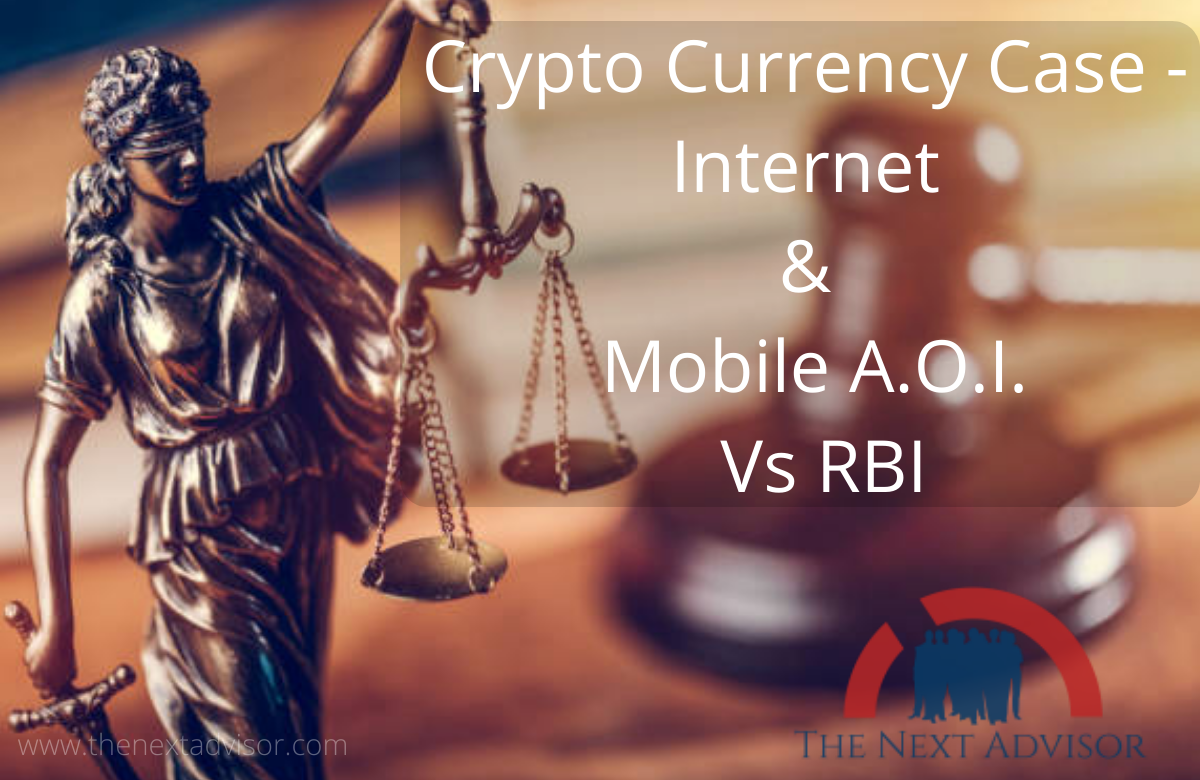Background of the Crypto Currency Case The name of the party of Crypto Currency Case is internet & Mobile Association Of India Vs RBI
• On 6 April 2018, the RBI had issued a Circular that prohibited banks and other entities regulated by it from both dealing in VCS, as well as from providing services to any individual or entity dealing with or settling VCs.
•The effect of the prohibition was that exchanges through which VCS were traded could no longer maintain and operate a bank account, thereby putting an end to the business of VC trading that required conversion from fiat currencies using formal banking channels.
•Pertinently, at the time the circular was issued, there was no legislative ban on the use and trading of VCS in India, and by the RBI’s proscription, VCS was ring-fenced from the formal economy.
•Earlier in 2013, the Reserve Bank of India does issue a public caution to the traders and holders. of virtual currency in context with the legal and security-related risks associated with it.
Reasons for the ban:-
• · loss to the economy ( hacking ) . money laundering
• can promote terrorist activities too.
Petitioners of Crypto Currency Case – Internet & Mobile Association Of India Vs RBI
The petitioner contended that the Reserve Bank of India does lack the jurisdictions to disallow the trade of virtual currency ( cryptocurrency ) moreover the ban imposed by RBI is disproportionate and violates the fundamental right of trade. The Petitioner also contended that virtual currency or cryptocurrencies are not a kind of legal tender or fiat money but a medium of exchange or a store of value.
Respondents of Crypto Currency Case – Internet & Mobile Association Of India Vs RBI
Respondents argued that the ban imposed by RBI is proportionate and does not violate the fundamental right of trade as it is a reasonable restriction considering the larger public interest. They also contended that Virtual currency or crypto currencies are a mode of digital payment which RBI do holds the power to have control.
First issue The RBI’s power to regulate VCS
•Relying on authorities including judgments of the courts in the USA. In UK and Singapore, it was asserted that there were four cumulative hallmarks of money – a store of value, a unit of account, a widely accepted medium of exchange, and serving as a final discharge of debt. While the first three insignia were characteristics of money in the social sense. The fourth trait was the characteristic of legal tender. While VCS did have the first two characteristics, not being widely accepted, they were not capable of being classified as money in the social sense.
•While not equating VCS to legal tender or fiat money, the Court was hesitant to accept the contention that VCS ‘ can never be regarded as real money. The Court concluded that even if something was not equivalent to currency but functioned as money ‘ under certain circumstances, the RBI had the power to deal with it in pursuance of its role as the apex regulator of the country’s financial system.
DOCTRINE OF PROPORTIONALITY
(1) Whether the objective of the measure is sufficiently important to justify the limitation of a protected right.
(2) Whether the measure is rationally connected to the objective.
(3) Whether a less intrusive measure could have been used without unacceptably compromising the achievement of the objective. and
(4) Whether, balancing the severity of the measure’s effects on the rights of the persons to whom it applies against the importance of the objective, to the extent that the measure will contribute to its achievement, the former outweighs the latter.
The second issue is The proportionality of the Circular
•The Court accepted that the right to trade could be subjected to reasonable restrictions, the restrictions had to be a measure that was proportionate to the concerns. It was highlighted that the doctrine of proportionality required that if alternative and less intrusive measures existed, those should have been adopted.
•The SC referred to the Report of the European Union Parliament titled ‘ Cryptocurrencies and Blockchain of July 2018. The ultimate recommendation made by the EU Parliaments is not to go for a total ban as there are less harsh alternatives to regulate the system.
•The Court held that the Circular was disproportionate because none of the RBI’s regulated entities had ‘ suffered any loss or adverse effect directly or indirectly, on account of the interface that the VC exchanges had with any of them. The thrust of the Court’s conclusion in this regard was that regulation would be a more proportionate response than prohibition.
•The court cited the case of State of Maharashtra v. Indian Hotel and Restaurant Association, wherein the court was of the view that at least suffered some degree of damage by the petitioner in order to pronounce the judgment in their favour.
Conclusion of Crypto Currency Case – Internet & Mobile Association Of India Vs RBI
The court was of in the Crypto Currency Case, view that although the Reserve Bank of India has wide powers and does play an important role in the upliftment of the Indian economy, here they are unable to show any sought of damage suffered by it is regulated entities. Therefore the guidelines issued by the Reserve Bank of India, directing the banks to stop dealing or providing services to the entities trading in virtual currencies are illegal hence unenforceable

























